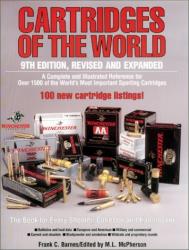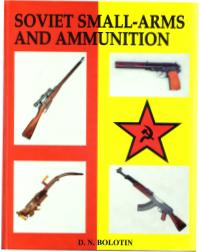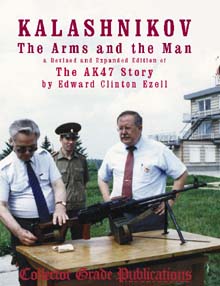CRUFFLER.COM
presents
Firearms
Technical Trivia, October 2001:
|
|
A Brief Look at
the 5.45x39mm Cartridge |
|
INTRODUCTION
The Russian interest in reduced
caliber cartridges for infantry rifles can be traced back to the early
20th century, with the development and issue of the Fedorov M1916 Avtomat.
Chambered for the 6.5x50mmSR Japanese service cartridge, the M1916 represented
the start of a trend away from conventional full power service rifle cartridges
that was to be the hallmark of Russian and Soviet ammunition development
through much of the 20th century. After the ravages of the First
World War and the subsequent civil war between white and red forces that
forged the Soviet State, reduced caliber cartridge development was resumed
and continued until the Second World War forced a reallocation of effort
and resources.
However, it was not until the American
military transitioned to the M16 rifle and its 5.56x45mm cartridge in the
1960's that serious development efforts aimed at creating a small-bore
cartridge to supersede the 7.62x39mm cartridge began. The result
was the 5.45x39mm cartridge, or 7N6, the advent of which was an event of
|
7N6 5.45x39mm
Ball Cartridge
|
critical importance
to the European military scene. One one level it represented strong
conservative bent typical of Russian and Soviet military thinking:
the adoption of the 5.45mm round permitted the Soviet and Warsaw Pact forces
to improve their basic infantry weapons without eliminating the technological
base upon which the older generation was grounded. On another level
it was a radical change: After a quarter century of cartridge standardization
within the Warsaw Pact, the Soviet Army took the decision to replace their
7.62x39mm arms - millions of AKM's and RPK's - with new versions firing
the 5.45mm round. Accordingly, the first reports of the new cartridge
befuddled western intelligence analysts who made the assumption that the
new small caliber rifles and machine guns would be used only by specialized
units. They simply could not believe that the changeover would be
a one for one replacement of existing stocks of |
rifles and squad automatic weapons because
of the logistical problems inherent to such a switch. The fact that
the Soviets were able to update their arsenal with 5.45mm weapons indicated
that their industrial sector was far more advanced than previously estimated.
The 5.45mm family of cartridges comprises:
|
7N6:
|
Ball |
|
7T3:
|
Tracer |
|
7T3M:
|
Modernized Tracer |
|
7U1:
|
Reduced Velocity |
|
7N10:
|
Armor-Piercing |
|
7KH3:
|
Blank |
|
7KH4:
|
Drill |
The cartridges were designed by a
"dream team" of modern Soviet small arms designers headed by Viktor Sabelnikov
and including Lidiya Bulavskaya, Boris Semin, Mikhail Fedorov, Petr Sazonov
and Petr Korolev. The basic characteristics of the 7N6 ball cartridge
are:
|
Cartridge Weight:
|
157.41 grains
|
|
Bullet Weight:
|
52.47 grains
|
|
Propellant Weight:
|
22.38 grains
|
|
Overall Length:
|
57mm
|
|
Case Length:
|
39.6mm
|
|
Case Type:
|
Rimless, bottlenecked
|
|
Bullet Length:
|
25.5mm
|
|
Propellant Volume:
|
1.56 cc
|
|
Maximum Chamber Pressure:
|
3,000kg/cm2 (42,670 psi)
|
The small caliber bullet matches
high muzzle velocity with excellent sectional density, resulting in a flat
trajectory and good penetration. Indeed, the standard ball cartridge
will penetrate 5mm of steel plate at a distance of 350 meters. Additionally,
the lowered recoil impulse of the 5.45mm cartridge (vice the 7.62x39mm)
had a beneficial effect on accuracy, increasing the fire efficiency of
the AK74 some 40 percent on average over the AKM.
The 5.45mm cartridge remains the
least powerful military rifle cartridge in general use. With a muzzle
velocity of 900 meters per second, it is significantly slower than the
NATO standard M855/SS109 5.56x45mm cartridge. Similarly, the 5.45mm
round, at 1,008 foot pounds, has less muzzle energy than the M855, which
can boast 1,325 foot pounds. It also has fifteen percent less case
capacity than the 5.56mm cartridge (and twenty-nine percent less case capacity
than the 7.62x39mm). The 5.45x39mm overcomes these apparent statistical
shortcomings
| in a number
of ways. To begin with, the bullet is not seated as deeply as in
the 5.56mm cartridges. Next, by using a shorter, fatter case, the
5.45mm's bullet could be designed such that it was ballistically efficient,
but still relatively short. Additionally the case shape makes for
significantly more efficient combustion that is possible with the 5.56mm's
longer, narrow case. Indeed, the 5.45mm's 3,000 fps muzzle velocity
is achieved with a chamber pressure that is almost twenty percent lower
than that of the 5.56mm. Finally, the 5.45mm uses an advanced, very
efficient propellant, with a combustion rate matched very |
5.45mm
Ball Projectile
|
closely to the cartridge characteristics.
The powder composition is 81 percent virgin nitrocellulose base material,
11.6 percent nitroglycerine, 5.3 percent ethyl centralite, 0.9 percent
dinitrotoluene as a stabilizer, and 0.4 percent undefined organics.
While the 5.45mm's high velocity
made for a flatter trajectory, and easier range estimation, there were
initial questions as to the 5.45mm's lethality. These later proved
to be unfounded, as the 5.45mm projectile is designed and constructed very
carefully so as to maximize lethality base on the cartridge characteristics.
(As an aside, western intelligence agencies initially postulated that
there might be a higher velocity 5.45mm cartridge for war usage.
As the initial samples were taken from the Afghan campaign, this was unlikely
at the time, and has since been disproven.) The AK74 rifle has
a 16.3" barrel with a rifling twist of 1:9.25", which results in a very
rapidly spinning bullet (approximately 233,513 rpm). As a result,
the projectile is extremely stable as it flies through the air. That
stability comes to a violent end as soon as the projectile enters a medium
that is more dense than air.
|
5.45mm
Projectile Cross Section
|
The basic
ball projectile (Russian military nomenclature 7N6) has a gilding metal
clad mild steel jacket. Inside the jacket is a lead sheath, which
in turn surrounds a 15mm long mild-steel core. The mild steel core's
base is mounted at the base of the bullet jacket. At the steel core's
nose is a 3mm long lead plug which is actually an extension of the lead
sheath. In front of the lead plug is an air space approximately 5mm
long. By placing the projectile's center of gravity toward the rear,
the design team virtually ensured that it would tumble end over end when
it struck a human body: When the bullet strikes a target hard enough
to deform its nose, the hollow cavity is crushed, and the center of gravity
changes rapidly, causing the projectile to upset and tumble. Once |
the bullet has begun to tumble, it quickly
transfers its kinetic energy into the target, thus bringing the maximum
wounding force to the target.
A roentgenogram
showing ten consecutive fired bullets (flanked by two unfired ones for
comparison) to illustrate that the core shift does in fact occur, and creates
an asymmetrical bullet.
Image credit:
Ezell, Edward C., The AK47 Story, (Stackpole Books, Harrisburg,
Pennsylvania: 1986) Page 243
|
This gains in importance when one recalls
that lethality is the product of the amount of energy deposited into the
target over time. Bullets such as the full power 7.62mm NATO tend
to be less lethal than the smaller, high velocity projectiles, because
such bullets tend to punch neat holes into and out of their targets, thus
not depositing much energy as as projectile that stops within the target.
| CONCLUSION
5.45mm
Wound Profile - Note extreme depth of wound and dual cavities
|
5.56mm Wound Profile |
While occasionally given short shrift
by American shooters and writers enamored with the 5.56x45mm, the 5.45x39mm
cartridge is an excellent round that offers comparable penetration, accuracy
and lethality to anything fielded by a NATO nation. It's also a historically
fascinating cartridge. Indeed, a strong case can be made that the
7N6's lineal ancestor is not Russian at all, but rather British.
The British Mk.VII .303 ball cartridge featured a bullet with either
an airspace or lightweight kapok filler at the nose that was designed to
tumble upon impact with the target. It is more than likely that the
Soviet team took a page from the British book when designing the 7N6.
And in a very timely manner, the 7N6 has come full circle: A cartridge
first tested in an Afghan war, designed with the experience of another
Afghan war in mind, may very well become the lingua franca of a third Afghan
war.
Note: Data
for this month's trivia page was gathered from:
Barnes, Frank
C., Cartridges of the World, 8th Edition, (DBI Books, Northbrook,
Illinois: 1997)
Cartridges
of the World is available from IDSA Books. Click on the image
to order.

Bolotin, D.N.,
Soviet
Small Arms and Ammunition, (Finnish Arms Museum Foundation, Hyvinkaa,
Finland: 1995)
Soviet Small
Arms and Ammunition is available from IDSA Books. Click on the
image to order.

Ezell, Edward
C., The AK47 Story, (Stackpole Books, Harrisburg, Pennsylvania:
1986)
Kalashnikov:
The Arms and the Man, an updated version of The AK47 Story,
is available from Collector Grade Publications. Click on the image
to order.

NEXT
HOME


